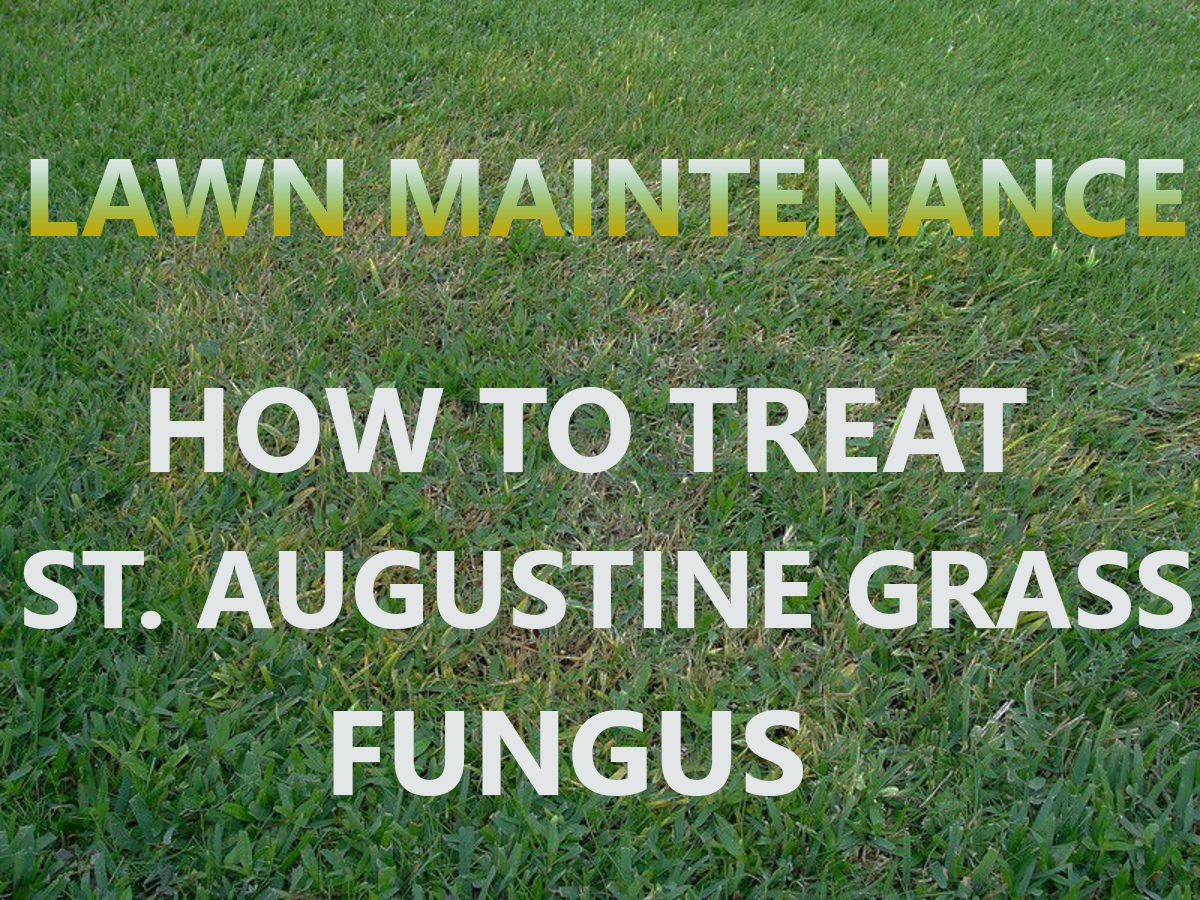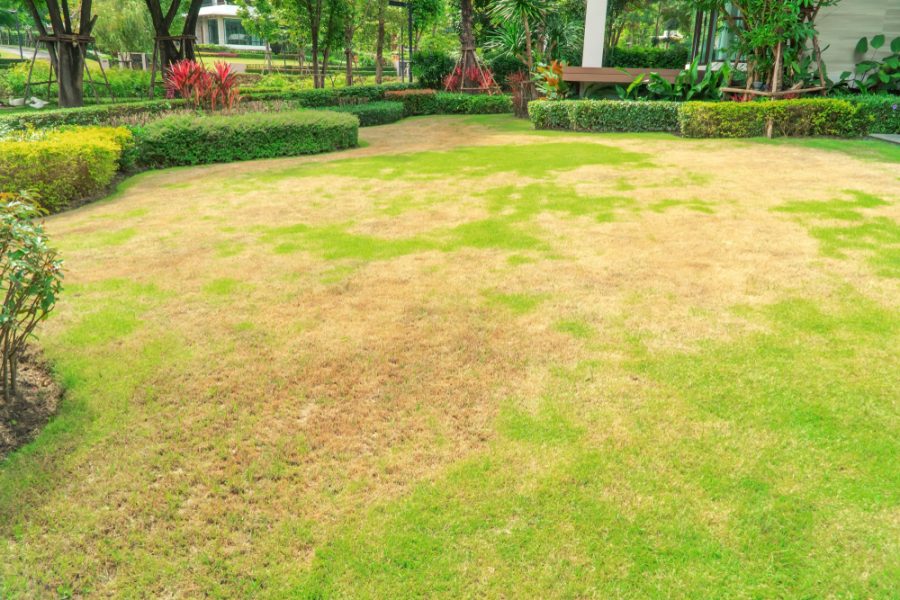St. Augustine is a lovely lawn grass that is native to tropical and subtropical areas of the world. The coloring is a deep green that lasts throughout the year, dulling only slightly in the dead of winter.
The grass blades are wide and flat, and they all grow in thick stolons which are usually packed tightly enough to diminish the possibility of weeds or other types of grass.
This type of grass is truly a wonderful option for any garden, but what do you do when you begin to notice the warning signs for fungus?
Brown blades and red growths are sure to ruin the look of your thick lawn, so treating fungus on St. Augustine grass is a must for any lawn lover.
The good news is that there are a few methods of which you can try to remove the fungus without having to spend too much time and money on doing so.
There are some natural methods as well as unnatural treatments, and you’ll have to find what works the best for your lawn.
Below we’ll be looking at the signs to look out for, what might be causing the fungus, and how to treat St. Augustine grass fungus.
Signs of Fungus on St. Augustine Grass
Unfortunately, due to the fact that St. Augustine is a compact grass, it can be susceptible to fungal infections when water gets trapped within the blades and cannot dry properly.
Having said that, it is true that St. Augustine is often resistant to this type of disease. So, don’t automatically presume the worst when you see a brown patch.
However, it is still important to identify if your lawn does have fungus or not. Not treating a fungal infection will only cause it to spread and infect even more of your garden.

The first key indicator of fungus invading your St. Augustine grass is brown patches or spots on the otherwise vibrant green lawn.
These patches can be sporadic and often begin in very small areas where you might not notice them straight away. Brown patches are very common and not always fungus.
If you find brown patches and want to be sure whether it’s a fungus or not, you can pull up a stolon and see whether that is also turning brown.
Stolons are responsible for spreading the St. Augustine grass, so if this is infected with fungus you can expect much more of your lawn to become infected quicker.
The next sign of fungus is yellowing blades that are seemingly random in their placement. This means that the yellow blades don’t necessarily have to be in one spot, they could be single and therefore very hard to notice at first.
Finally, perhaps the most obvious indicator is fungal threads. These are dark in color, most commonly brown but they can also be bright red. These threads will be covering the stolons or the crown of the grass.
These can sometimes look like thin dead blades of grass, so be careful that you’re not confusing the two and dismissing the problem.
There is no rhyme or reason to the patches of grass that get infected with fungus - sometimes there are lots of little patches and others it’s just one big area. Sometimes it’s a mix between small and large infected areas.
The quicker you catch the fungus the better, as there is less of a chance that it will have spread throughout the stolons.
So, don’t ignore that browning patch on your lawn - it could be the start of a relentless infection.
How to Treat Fungus on St. Augustine Grass
If all indication points to a fungal infection, your diagnosis will more often than not be correct.
So, what you need now is an effective treatment for the disease - pronto. Having said that, there isn’t just one uniform type of fungus out there.

In fact, there are three main types of fungal infection for St. Augustine grass and a different method of treating all of them.
Let’s take a look at treating the infection depending on the type of fungi.
Grey Leaf Spot Fungus
Grey leaf spot fungus is an infection that only affects St. Augustine grass. This fungus causes yellow or white patches on your lawn and is most commonly found during high humidity weather.
This fungus can also occur if you over-fertilize your grass.
This type of fungus can be treated with a fungicide such as an azoxystrobin or thiophanate-methyl.
Fungicides are chemicals that effectively kill fungus quickly without harming the grass. Make sure that you use a high-quality option and stick to the instructions.
Fairy Ring Fungus
Fairy ring fungus is one of the more noticeable kinds of fungus, as it often produces rings of mushrooms around the affected area.
Again, fungicides can treat fairy ring fungus without much trouble at all, but there is also a more natural method of doing so.
Remove the white soil that surrounds the ring of fungus as well as the infected grass itself. Make sure to leave no white particles within the soil as this increases the chances of reappearing infections.
Once you’ve removed all of the infected matter, lay down a new sod of St. Augustine grass to fill in the gaps in your lawn.
Grease Spot Fungus
Grease spot fungus is commonly diagnosed by looking at the blades of grass. If they’re sticky, like a layer of grease is covering them, they might be infected with this type of fungus.
St. Augustine is never supposed to have a sticky feeling, so if your lawn does have this you might want to look into possible causes.
Treat this fungus with a number of different fungicides that you can find on the market. Grease spot fungus is well-known for becoming resistant to treatments, so you’ll have to switch up your routine to ensure that the fungus is killed effectively.
Other Fungi
The three types of fungal infection for St. Augustine grass that we mentioned above are not the only infections that your grass can become subject to. However, the good news is that fungicides will more often than not kill the fungus easily as long as you follow the brand’s instructions.
However, there is always the possibility that a fungus will have grown too powerful to be rectified with a chemical treatment.
In cases such as these, it might be worth removing the infected grass and starting again with fresh sod. This will save you a lot of wasted time and hassle.
Causes of Grass Fungus
Now that we know how to treat the different types of St. Augustine fungus, let’s look into what might be causing it to grow.
If you remove the infection but leave the cause untouched you might find that the fungus comes back quickly, throwing you all the way back to square one again.
Some causes are unavoidable, such as high humidity in the air or lots of rainfall. Areas with more extreme weather conditions are often more likely to experience St. Augustine fungus taking over their garden.
It would be unreasonable to move to a completely different area just because of some grass fungi, right?

However, some causes can be easily avoided with some simple steps. One of the most common causes of St. Augustine fungus is overfertilizing or overwatering. While you want to find the right balance between over- and under-watering, you must consider the dangers of the former.
Do your research and make sure that you’re not fertilizing your lawn more than the manufacturer of the fertilizer suggests. To get an even better idea of how much fertilizer and water to give your lawn, search the internet for answers that are specific to St. Augustine grass.
Compact soil is another common cause of fungi on St. Augustine grass. To rectify this, you can aerate the soil beneath the grass to offer it a better drainage system. This will prevent water from pooling and having nowhere to go, offering a great breeding ground for the fungus to spawn.
The shade is often another cause for concern with St. Augustine grass. Although this type of grass is regarded as very shade tolerant, shade prevents moisture from drying between the blades and therefore offers a nice place for fungus to grow.
Although you cannot always control the shade on your lawn, there are sometimes ways to work around it.
Moving tall furniture can help keep the shade to a minimum, and you can also install grow lights around your lawn to keep the blades nice and dry.
Summertime is the ideal time for fungi to infest your lawn as the hot temperatures heat up the moisture locked in the grass and offer the infection the ideal breeding ground.
Finally, another potential cause is lawn neglect. If you don’t water your lawn enough or don’t look after it as much as necessary, it might rebel and allow the fungus to set in.
St. Augustine grass doesn’t require as much maintenance as some other types of grass, so ensuring that it’s looked after will take you much less effort than to try and eradicate the fungus.
Preventative Measures
If you’ve recently treated your St. Augustine grass for fungi, or you’re looking to prevent it from occurring in the first place, there are a few handy preventative measures that you can implement into your schedule.
Following through with these will certainly help you fight the possibility of fungal infections, so what’s the harm?
Below we’ll be looking at four different preventative measures that are easily done to leave you with peace of mind and a healthy-looking lawn.
Adding nitrogen to the soil
Nitrogen helps to keep the grass healthy and prevent fungal infections from setting in. You can easily increase the nitrogen levels by leaving the grass clippings scattered over the lawn after you’ve trimmed it.
This will allow nitrogen to penetrate the soil that would otherwise be raked away and disposed of.
Similarly, you could purchase a nitrogen fertilizer that will boost the levels of nitrogen within the soil. Remember that fertilizer should only be used during the growing season - otherwise, you might fall into the trap of overfertilizing.
Aerating the soil
Aerating the soil prevents a moisture build-up within the blades of grass by giving the water somewhere to go.
This can be done by a number of objects, and you can also purchase a specialized aerator. You can aerate the soil as much as it’s needed during the autumn, winter, and spring.
Dethatching the lawn
Thatch is a matted layer of dead grass and debris that sits on top of the grass. If this isn’t raked away and looked after, the thatch builds up and creates a barrier between the soil and the rainwater. This can easily cause a fungal infection if you’re not careful.
So, removing the thatch off of your lawn is always a good idea during the growing season. For St. Augustine grass the growing season is from spring to the end of summer.
Changing the watering schedule
You should change the watering schedule for your St. Augustine lawn during the different seasons.
Dry soil is also another great place for fungi to grow, so you want to make sure that the soil is not too wet but also not too dry. During the growing season, you should increase the amount of water you’re giving to your lawn to avoid the soil from drying out.
Final Say
We hope that you have learned something valuable about how to treat St. Augustine grass fungus.
Once you’ve diagnosed your lawn, make sure to treat it quickly and thoroughly to avoid it coming back. Consider changing some of the potential causes of fungus so that you don’t have the same problem again.
Always implement at least one preventative measure into your usual routine.
Remember, these preventative measures are much easier and less expensive to carry out than the task of killing fungi off of your lawn, so make sure that you make the right choice.

